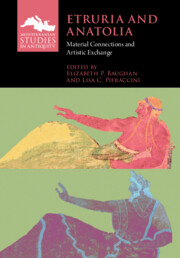Book contents
- Etruria and Anatolia
- Mediterranean Studies in Antiquity
- Etruria and Anatolia
- Copyright page
- Epigraph
- Contents
- Maps and Figures
- Contributors
- Preface
- Acknowledgments
- Notes on Abbreviations and Spelling
- Introduction
- Part I Broadening Perspectives
- Part II Interpretive Frameworks
- 2 Bridging Cultures in the Past and Present
- 3 Etruria and Anatolia
- 4 A Tale of Two Buccheri
- 5 The Role of Greek Sanctuaries in Material and Artistic Interactions between Etruria and Anatolia
- Part III Technology and Mobility
- Part IV Shared Practices
- Part V Shared and Distinct Iconographies
- Part VI Shared Forms, Distinct Functions
- Index
- References
4 - A Tale of Two Buccheri
East and West
from Part II - Interpretive Frameworks
Published online by Cambridge University Press: 02 March 2023
- Etruria and Anatolia
- Mediterranean Studies in Antiquity
- Etruria and Anatolia
- Copyright page
- Epigraph
- Contents
- Maps and Figures
- Contributors
- Preface
- Acknowledgments
- Notes on Abbreviations and Spelling
- Introduction
- Part I Broadening Perspectives
- Part II Interpretive Frameworks
- 2 Bridging Cultures in the Past and Present
- 3 Etruria and Anatolia
- 4 A Tale of Two Buccheri
- 5 The Role of Greek Sanctuaries in Material and Artistic Interactions between Etruria and Anatolia
- Part III Technology and Mobility
- Part IV Shared Practices
- Part V Shared and Distinct Iconographies
- Part VI Shared Forms, Distinct Functions
- Index
- References
Summary
The word “bucchero,” most commonly used to describe the black ceramics produced in Etruria, began to be used for pottery made elsewhere in the Mediterranean that relied upon the same technology – an oxygen-reducing kiln environment to achieve a firing that is dark through the biscuit and requires no slip or glaze. This chapter questions whether the term “bucchero” was ever used for ceramics from Anatolia in order to support Herodotus’ claim that the Etruscans were immigrants from Lydia. An examination of literature from the early twentieth century through today reveals that bucchero is understood as a “national” pottery for the Etruscans but is not a defining ceramic for any other culture. Therefore, while “bucchero” is used in a variety of contexts, it is indelibly linked with Central Italy. Over time, publications gradually shifted toward using “bucchero” only for Etruscan ceramics and “grey ware” for East Greek material, at times explicitly rejecting the use of the word for anything other than Etruscan material. Instead of uniting ancient cultures or demonstrating influence through shared ceramic technology, this term became a way to separate them.
Keywords
- Type
- Chapter
- Information
- Etruria and AnatoliaMaterial Connections and Artistic Exchange, pp. 87 - 97Publisher: Cambridge University PressPrint publication year: 2023

